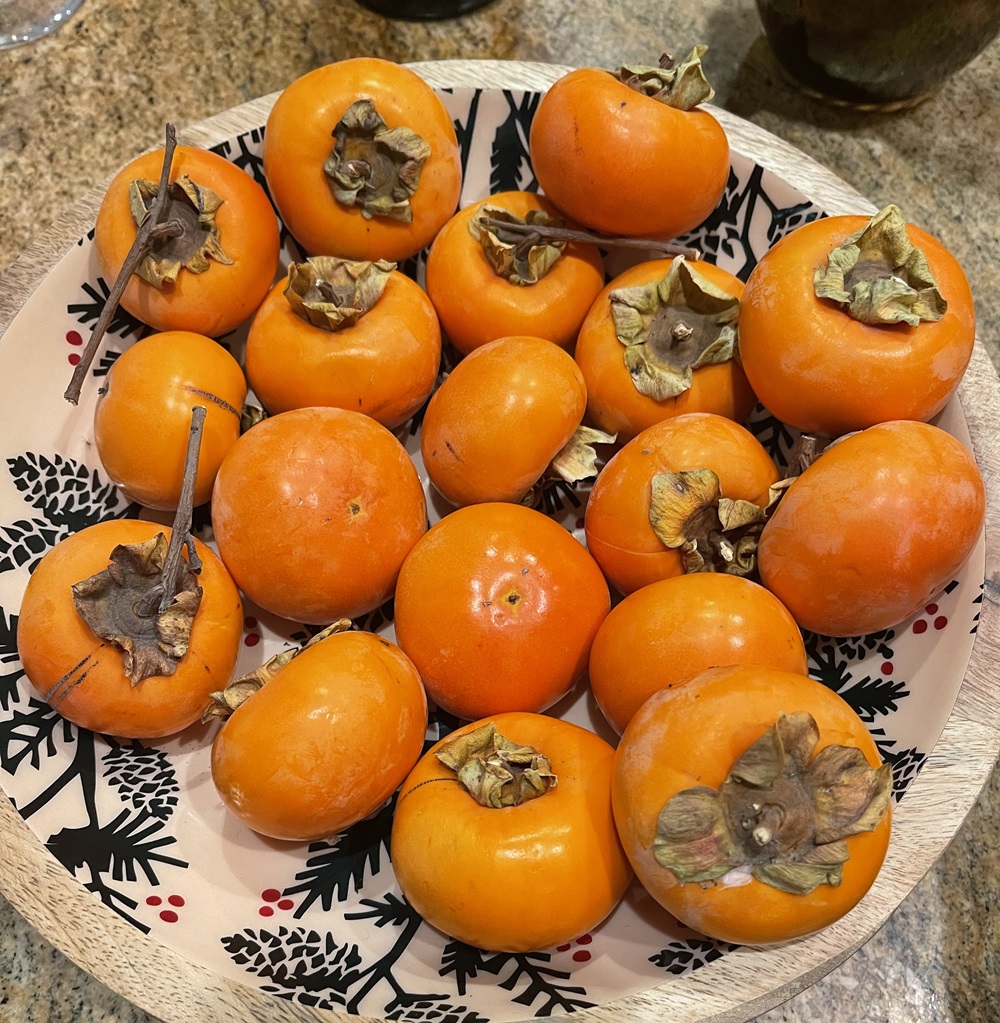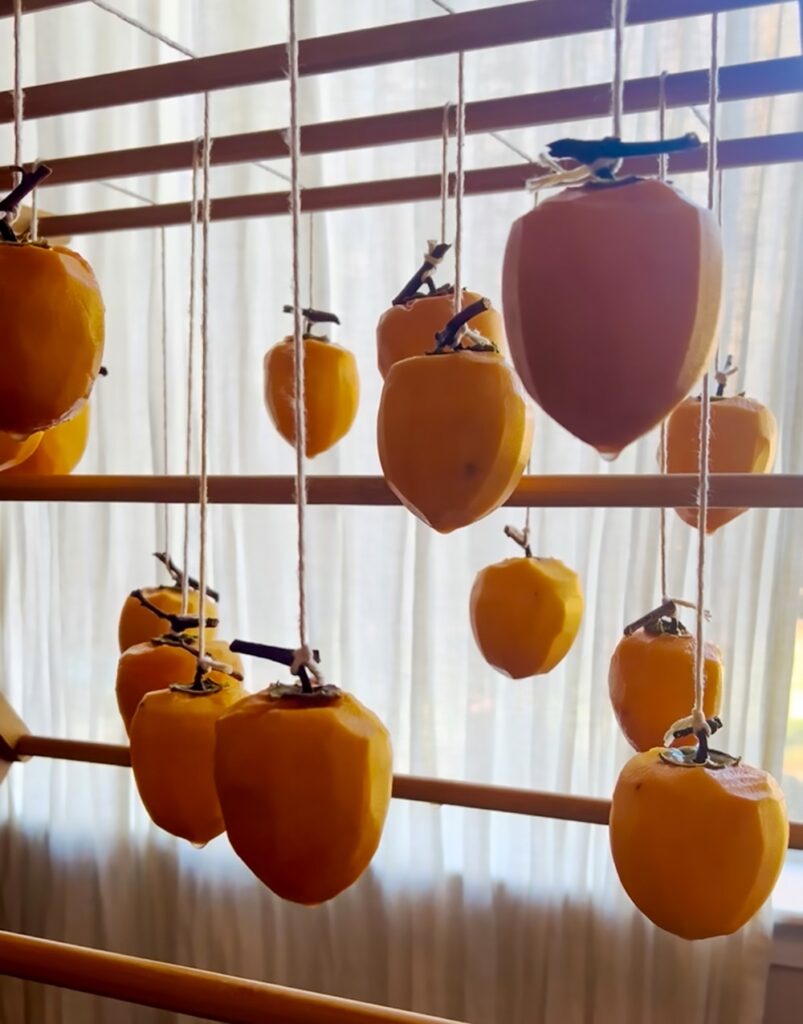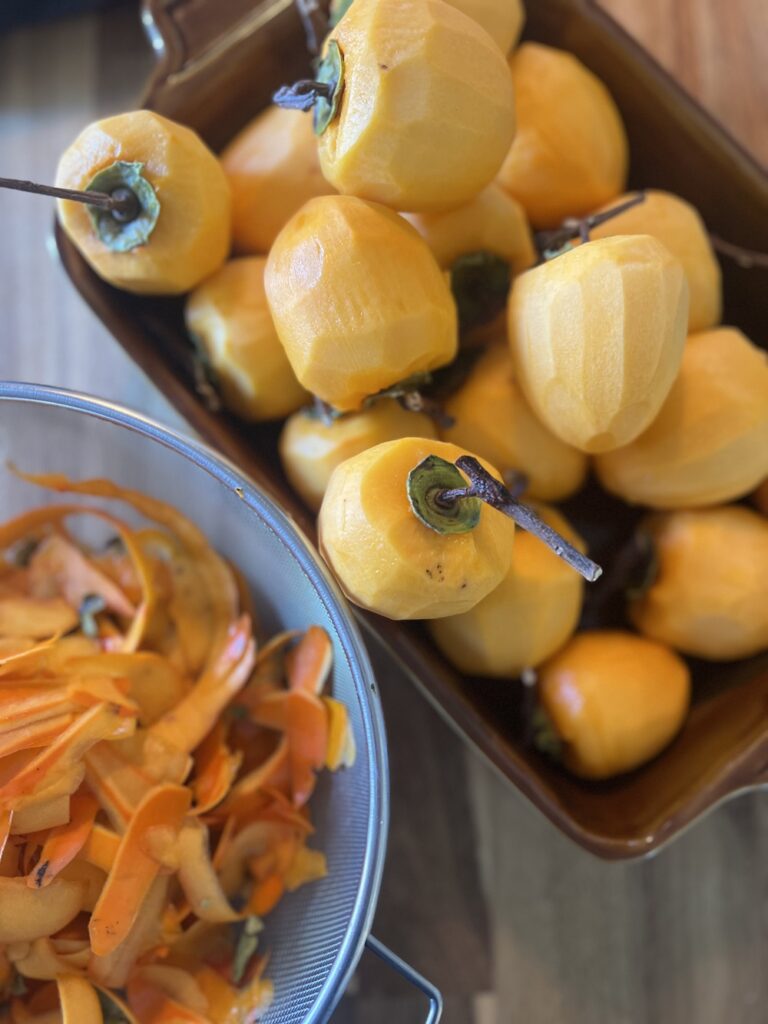Winter Wonder
Making Hoshigaki – Japanese Perserved Persimmons
Medicine Meal explores the intersection of food and herbs as medicine. The name comes from the Japanese Yakuzen culture, which is about creating delicious, healing meals using traditional Chinese medicine herbs and principles.
Photos by: Erin Wilkins, L.Ac.
According to Traditional Chinese Medicine (TCM), the cold weather and long nights of winter draw our energies inward from early November to early February. It is a time of year to retreat into our homes, cultivate warmth, and pause to restore and replenish our deepest energy reserves.
Winter is associated with Yin energy, which reflects stillness, introspection, and slowing down to honor the natural rhythms of the season. Yin energy is our foundation—it fuels creativity, juicy vitality, and the body’s deepest energy reserves. However, overextending yourself, whether through late-night work, strenuous exercise, holiday stress, or relying on caffeine to push through tiredness, can deplete this Yin energy when you need it most. Exhaustion in winter can be especially damaging, even if its effects are not felt until the following year, when your energy reserves fall short.
To replenish Yin, you need consistent rest and self-care practices. This isn’t about just taking a day off; it requires ongoing commitment. Prioritize time to reflect, dream, meditate, share stories, journal, and nap. Keep your body warm—particularly your back, which helps protect and support Yin. Consider what truly nourishes you, and focus on practices that fill your cup, replenishing your deep energy during this season.
Hoshigaki
JAPANESE PRESERVED PERSIMMONS
Hoshigaki, the Japanese way of air-drying hachiya persimmons, mirrors the seasonal self-care practices of Traditional Chinese Medicine (TCM). Just as winter calls for nurturing our Yin energy. Making hoshigaki allows us to experience patience, tenderness, and mindful attention.
In preparing hoshigaki, each persimmon is peeled, dried, and hand-massaged over several weeks, allowing the fruit to transform into something more complex and sweet. This gentle, deliberate process reflects how we can care for ourselves during the winter. Just as the persimmons need gentle tending to bring out their full potential, we also need to nurture ourselves with rest, warmth, and tending to our daily needs with nourishing foods.
In making hoshigaki and in caring for ourselves, the key is to honor the natural rhythms of the season. By embracing stillness and replenishing our Yin, we allow ourselves to thrive through winter and emerge into spring with renewed strength and balance.
Ingredients and Supplies:
12+ Hachiya persimmons
Folding laundry rack, curtain rod, or area to hang the persimmons
Electric fan
String or kitchen twine
Medium-large pot
Instructions:
Choosing the persimmons: Hachiya persimmons have an oval, elongated shape and look like a large acorn. They grow well in Sonoma County, and when harvesting, choose medium to large fruits that are dark orange in color and firm or slightly soft to the touch. Cut them at the branch, leaving a ½ inch T-shaped stem attached to each fruit.
Wash and Peel: Wash and dry the persimmons. Using a vegetable peeler or paring knife, carefully remove the peel while leaving the calyx (hard fruit cap) and stem intact.
Prepare Twine: Cut kitchen twine into 18-inch lengths. You’ll need one length of twine for every two persimmons. Tie each end of the twine to the persimmon stems, trimming any excess so the twine doesn’t touch the fruit. When draped over a drying rack, each persimmon will hang from opposite ends of the twine.
Sterilize: Bring a medium-large pot of water to a boil. Holding the twine, dip the persimmons into the boiling water for three seconds. This step sterilizes the fruit and helps prevent mold during the drying process.
Drying Setup: Hang the persimmons on a drying rack near a sunny window or an indoor area with good natural light. Ensure the fruits are not touching each other. Place newspaper or parchment paper under the rack to catch any drips during the first week.
Air Circulation: Use a small fan to help circulate air and speed up drying while keeping fruit flies away. If any mold appears (black or white spores), scrape it off with a clean knife and dab the area with a bit of clear liquor, such as vodka.
First Week: The persimmons should feel dry to the touch after the first week. Begin gently touching the fruits once a day with clean, dry hands. Around the third day, the fruits will start to soften and shrivel. At this point, begin gently massaging the fruits every few days, taking care not to squeeze them.
Continued Drying: Continue the drying and massaging process for up to four weeks. The fruit should become firm and brown on the outside, with a soft interior. You’ll also notice a natural white sugar crystallization on the surface—this is normal and not mold.
Final Check: When ready, the hoshigaki will have a raisin-like chew and a vanilla-caramel sweetness. Taste a slice to check.
Storage: To preserve your hoshigaki, cut off the twine and store the fruit in a plastic storage bag or glass container in the refrigerator or freezer. They’ll keep for up to one year.
Enjoy your hoshigaki by slicing it like any dried fruit for a naturally sweet treat! During the holidays, I add them to charcuterie boards with nuts, locally sourced cheese from the Petaluma Cheese Shop, and cured meats from Canteen Meats in Petaluma.
Recipes and text excerpted from Asian American Herbalism: Traditional and Modern Healing Practices for Everyday Wellness by Erin Masako Wilkins. Published by Princeton Architectural Press, owned by Chronicle Books. Copyright © 2023 by Erin Masako Wilkins.
Disclaimer: Be sure to identify plants properly when foraging for wild plants. Exercise caution and seek guidance from experienced foragers. Consult a qualified healthcare professional before taking new herbal supplements or changing your diet, especially if you are pregnant, nursing, immunocompromised, or on medication. As always, seek outside help if something doesn’t feel right for you.




